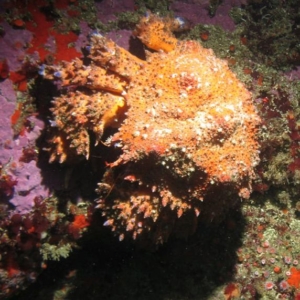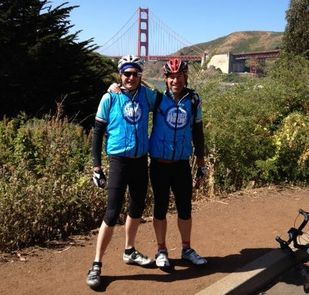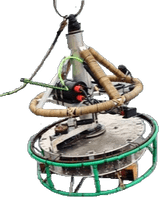A Message From The Executive Director

Fifteen years ago, MARE was founded with the goal of illuminating the ocean’s mysteries and filling the overwhelming gap in information about what lies beyond SCUBA depth. MARE and its partners deployed robotic submarines to collect a vast amount of deep sea data and analyzed it to provide the critical information needed to safeguard healthy oceans for generations to come.Last year we saw our hard work pay off in several long-term, high impact projects including:
• Completion of four multi-year deep sea survey programs
• Development of the long-term monitoring plan for California’s network of marine protected areas (MPAs)
• Exploration and documentation of critical deep sea coral and sponge ecosystems
We are excited to share more about these important projects in this annual report!
I am proud of these achievements and deeply appreciate our partners and supporters who made them possible. Our work is far from done, however. We are facing unprecedented risks to the ocean’s health. Offshore oil and gas exploration, deep sea mining, and destructive fishing practices threaten to inflict irreversible damage to valuable ecosystems and marine life.
If we do not act now, recovery may not be possible in our – or our grandchildren’s – lifetime. MARE’s work brings to light the most meaningful information about the deep sea. In the hands of key stakeholders, our imagery and data are used to generate new practices and legislation to protect the ocean. By supporting MARE, you address these critical risks head on by bringing science to action and creating change. Thank you for your commitment to ocean conservation and for supporting this legacy work. We look forward to another year of exploration and discovery together!
Our Impact
MARE Year in Review : PROJECT HIGHLIGHTS
North Coast Marine Protected Areas Assessment
Ocean Sunfish (Mola mola) captured while surveying the North Coast Marine Protected Areas.
California is home to the largest scientifically-based network of marine protected areas (MPAs) in the nation. As these protected areas were put in place, baseline assessments were performed to set the benchmark from which changes will be measured. Working closely with state agencies and academic institutions, MARE surveyed many of the deep water sites from 2010 through 2015.
In 2017 MARE completed the final region – a complete characterization of deep water sites along the rugged North Coast. These MPAs included Point St. George Reef Offshore SMCA, Reading Rock SMR, Mattole Canyon SMR and Ten Mile SMR. MARE’s final report to California Sea Grant included identification of the marine life and associated seafloor habitats, as well as recommendations for future monitoring strategies and key ecosystem indicators for inclusion in the statewide long-term MPA monitoring plan.
MARE staff presented at Humboldt State University’s Marine and Coastal Science Institute North Coast MPA Baseline Monitoring Symposium in May 2017. Key findings were reported from the first comprehensive study of Northern California’s nearshore waters by MARE and other researchers, management agencies, and nonprofit organizations.
Read MARE’s North Coast Baseline Program Final Report: Mid-depth and Deep Subtidal Ecosystems to learn more about this project:
CALIFORNIA COAST SURVEYS

Vase Sponge, Basket Star (Gorgonocephalus eucnemis)
MARE partnered with California Department of Fish and Wildlife (CDFW) to assess commercially and recreationally important fish and other marine species, as well as characterize much of the rocky habitats of our state waters. The findings will be used to examine the condition of habitats important to over-fished species inside and outside selected MPAs, and most importantly, inform management decisions in the future.
MARE conducted the fifth and final survey of this project in 2017 with a 30-day effort along the Central Coast region. Video imagery collected was analyzed by MARE’s scientists and a final technical report was provided to CDFW for use in the State’s deep-water monitoring efforts. With the completion of the Central Coast survey, MARE and CDFW have now filmed and surveyed more than 1,800 km (5.2 million sq. meters) at 163 sites from Oregon to the Mexican border.
DEEP SEA LONG TERM MONITORING

Diamondback Tritonia (Tritonia festiva)
With the baseline characterization of California’s marine protected areas completed, MARE helped develop the Statewide MPA Monitoring Action Plan, which will guide the long-term monitoring of California’s MPAs. In April and June of 2017 MARE worked with researchers, management agencies and academic institutions to inform development of the deep-water ecosystem monitoring framework, which will guide the State’s long-term monitoring efforts. A comprehensive list of management questions, and the most important taxa and habitats to monitor were identified during these multi-day workshops. This critical foundational work will guide the State in developing a long-term monitoring plan that serves across agencies and mandates as we monitor the ocean health.
EXPLORING CHANNEL ISLANDS DEEP-SEA CORAL
Bluntnose Sixgill Shark (Hexanchus griseus) captured at 295 meters during this survey.
In April 2017, MARE joined the Channel Islands National Marine Sanctuary’s (CINMS) research coordinator, Chris Caldow, and National Oceanic and Atmospheric Administration’s (NOAA) deepwater coral and sponge researcher, Dr. Peter Etnoyer, to explore the deep-sea corals of the Santa Barbara Channel Islands. During the two-week survey, aboard the 210 ft.
NOAA research vessel Bell M. Shimada, we explored undescribed habitats to study the condition of deep-sea coral gardens and document seafloor environments. Using MARE’s ROV Beagle, we captured video of fish and deep-sea coral communities. Several coral samples were also collected within the CINMS for use in laboratory studies and genetic analysis
DIVING DEEPER INTO HISTORICAL DATA

Western Sand Dollars (Dendraster excentricus)
In 2007 and 2008 the deep-water portions of select Central Coast MPAs were surveyed by the California Department of Fish and Wildlife (CDFW) using an ROV. Video collected during these surveys was initially analyzed to characterize the benthic habitats and fish populations, but not invertebrates. Seeking to achieve a more comprehensive view of these ecosystems and to align historical data sets with those currently being processed, the Ocean Protection Council (OPC) and CDFW contracted MARE to analyze archival video from those surveys to quantify macro-invertebrate species. The result of this effort provided a more comprehensive profile of the deep rocky and soft-bottom ecosystems in this region.
The same was done for sites near the Northern Channel Islands, originally surveyed from 2005-2009. With its completion, the data on invertebrate abundance is now comparable to data collected by MARE in 2014 and 2015 at the same historic sites, creating a an invaluable data series over 10 years to be able to further examine changes in ocean health.
MARE TECHNOLOGY: Our Window to the Deep
30 METERS DEEP
SCUBA Research Depth
Research divers are typically limited to depths shallower than 30 m. MARE’s fleet of robotic vehicles specialize in surveying ecosystems beyond this depth.
100 METERS DEEP
Benthic Assessment Towfish (BATfish)
This lightweight, maneuverable, towed glider provides HD video and is easy to operate from a small boat with minimal crew, at depths down to 100 meters.
250 METERS DEEP
Hammerhead ROV
Our fully retrofitted Phantom-class ROV, the Hammerhead, is customized to gather marine habitat and biological information at depths of 15 to 250 meters.
350 METERS DEEP
Stereo Video Lander
Our stationary stereo camera system, with 360 degree rotation, allows researchers quick access to marine habitats at depths down to 350 meters.
1,000 METERS DEEP
Beagle ROV
Our flagship vehicle is used for detailed ocean imaging and sample collection. The Beagle delivers live HD video and stereo video imaging and is rated to 1,000 meters.
ON THE HORIZON : 2017 and beyond
CORAL AND SPONGE EXPLORATION
Giant Pacific Octopus (Enteroctopus dofleini) in a coral garden in the Channel Islands.
Concern has arisen that deep-sea ecosystems are rapidly being impacted by human activities, including bottom-contact fishing, oil and gas exploration, cable deployment, and ocean dumping. These activities have caused severe damage to deep-sea ecosystems worldwide, and the rate of damage is accelerating.
The loss of these critical habitats is already having cascading effects on many of the marine organisms that depend on them, including commercially important fish species. Critical structure-forming environments such as deep-sea corals and sponges have recently been identified as essential fish habitat worldwide, yet little is known about where they exist or how they function in the life history of many commercially exploited species
The lack of information about deep-sea corals and sponges limits efforts to protect them. MARE believes that systematic efforts are required to fill the existing information gaps and ensure that these fragile ecosystems are adequately protected, while continuing to support sustainable fisheries. In 2018, MARE, in partnership with Marine Conservation Institute, will launch our Deep-Sea Coral Program, a three-year effort to provide critical, actionable knowledge of deep-sea coral and sponge habitats. Initially, the program will address three key information gaps: lack of agreement on the extent of habitats to be protected; lack of information about the current distribution of deep-sea corals and sponges; and lack of effective predictive mapping tools to reduce the costs of exploration and documentation.
LONG-TERM MPA STATEWIDE MONITORING

Puget Sound King Crab
(Lopholithodes mandtii)

Pacific Electric Ray
(Torpedo californica)

Ochre stars
(Pisaster ochraceus)
With the baseline characterizations of California’s MPAs completed, the State will now begin long-term MPA monitoring. MARE will continue its long-standing partnerships with state and academic institutions by being a key player in tracking changes in the deep-water habitats of California’s MPAs over time. Survey protocols developed in partnership with CDFW and MARE have now been used statewide, resulting in the largest deep-water MPA baseline dataset to date. This data will become the benchmark from which future changes will be evaluated.
STATEMENT OF ACTIVITIES

DONORS
DONOR SPOTLIGHT: Sam Schuchat
 Sam Schuchat, an outdoor enthusiast from a young age, is dedicated to protecting our environment. His childhood passion extended to a career in conservation, where he serves as Executive Director of the California Coastal Conservancy.
Sam Schuchat, an outdoor enthusiast from a young age, is dedicated to protecting our environment. His childhood passion extended to a career in conservation, where he serves as Executive Director of the California Coastal Conservancy.
Sam got involved with MARE in 2003 during the State of California’s implementation of a network of marine protected areas (MPAs). As Sam notes, “you can’t conserve what you don’t know you have. The sea floor is the driver for habitat.” Executive Director Dirk Rosen presented MARE as the most cost-effective and accurate solution to gather data needed for initial monitoring of the newly created MPAs. Thus launched a partnership between their organizations.
MARE has given Sam an opportunity to blend his personal and professional passions further. For instance, being a member of the Climate Ride Ocean Riders Team offers a perfect opportunity for Sam to combine his loves of cycling and coastal conservation. Sam has accompanied Dirk on two rides and is planning another for the fall in the Pacific Northwest.
Sam recognizes that MARE captures the ocean in a uniquely accessible way. He fondly recalls a MARE expedition to the Santa Barbara Channel Islands in 2004: “I could watch “Fish TV” all day!” Sam notes that he was addicted to the live streaming video during the expedition. “You don’t have kittens – but you have octopus and wolf eels!”
Sam contends that support of MARE is critical. In the midst of our current political fight to protect our natural resources, “we need baseline information more than ever.” Leaders and organizations like Sam, California Coastal Conservancy and MARE have helped California protect our coasts with MPAs and effective fisheries regulations. Thanks to supporters and partners like Sam, MARE’s work to better understand deep water ecosystems, and put information into action, is just getting started.
DONORS: July 1, 2016 – June 30, 2017
$50,000+
Anonymous
Campbell Family Foundation
Paul M. Angell Family Foundation
$25,000 – $49,999
Dean Witter Foundation
HRH Foundation
Margolis Family Foundation
$10,000 – $24,999
Bay Area Beverage Company
Jorgen Carlsen
Climate Ride
$2,500 – $9,999
Anonymous
Bonnell Cove Foundation
Emmett Family Foundation
Larry L. Hillblom Foundation
J.W. & H.M. Goodman Family Foundation Charitable Foundation
Allan & Laura McCarthy
Peter J. Davis Family Foundation
James Tustin
Karen & Pete Weber
$1,000 – $2,499
Alicia Bihler & Owen Bissell
Jeff Chanin
Ron Clausen
Rick & Patricia Davenport
Kerry Davidson & Dan Fitzgerald
Deepflight
Donald & Randee Disraeli
Environmental Defense Fund
Michael Gallagher
Hobson Family Foundation
John Hubenthal & Jen Dito
Brent Ledvina & Kristi Teplitz
Jeff & Mia Ludlow
Laura Marlin
Mechanics Bank
Brian and Heidi Miller
Robert & Nancy Praetzel
Dirk Rosen & Pamela Rich
Lawrence & Ruth Rosen
Martin & Joan Rosen
Sam Schuchat & Ilana De Bare
Gary Simpson & Jill Nida
Philip Stevens
$500 – $999
Maureen Blanc
Mark Benjamin
Bruce & Barbara Callander
Seth & Allison Ferguson
Michael Gallagher and Ruth Shapiro
Jonathan Glassman
Jim Jones
Ravindran Kannan & Shuba Raghavan
Star Pierce
Genie Praetzel & Boyd Davis
Bill & Katie Shelmerdine
Marjorie & Ralph Winkler
Up to $499
James & Rebecca Austin
Jim Barnes & Liz Frome
Natasha Bell
Gregg & Lisa Bemis
Aimee Brown
Alison Bradley
April & Glenn Bucksbaum
Samantha Carpenter
Michael Casey & Lisa Whitaker
Blakesley Chappelet
Clyde Charlton & Michelle Baumgartner
Pat Conroy
Al Coppin
Coast Central Credit Union
Alexandra Connell
Sandra Curtis
Greg Flejtuch & Marla Filipponi
M. Patricia Flanigan
Aviva Garrett & David Doshay
Lina Ghanem
Philip Harvey
Humboldt Recycling
Paulo Iuliano & Emily Barker
Patricia Jackson
Michael & Barbara Johnson
Christopher & Camilla Kieliger
Craig & Chris Lauderdale
Gary Lucks
Bradley Mart
David & Laura Miller
Muddy Waters Coffee Company
Anne-Marie Praetzel & Francisco Di Domenico
Matt Praetzel
Deepak Puri & Shareen Punian
Ramone’s Bakery & Café
Leslie Reed
Redwood Capital Bank
Shirley Rosseau
Angela Rule
Roger & Loreen Ruegg
George & Linda Sensabaugh
Anna Stern
Sheela Subramanian
Tae Oh
Lisa Thomas
Dirk Van Waart
George Wagner
Peter Waldman & Charene Zalis
Karyn Gear & Cliff Waldeck
Shelly Willard
Valerie & Howard Wynn
THANK YOU








